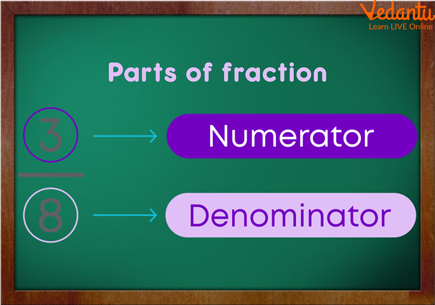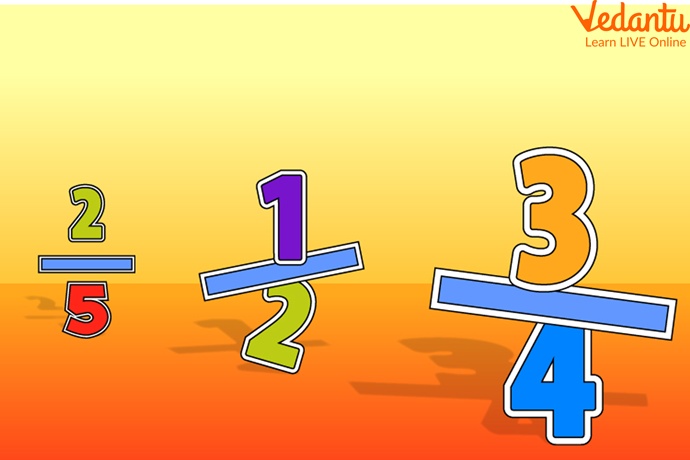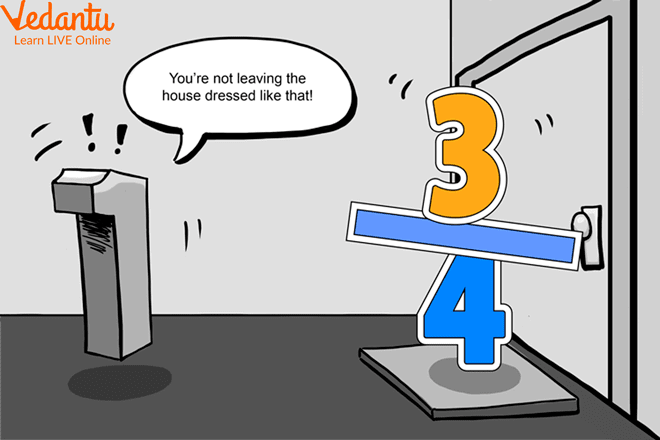




How to Convert Between Vulgar and Decimal Fractions
Do you know another name for a common fraction? A fraction in which the numerator and denominator are both integers. Vulgar fractions are simply two integers placed above and below a fraction bar (the numerator and denominator). A vulgar fraction, also known as a common fraction or fraction, is a fraction written in the conventional form, with one integer number written above the next and a line between them.

The Numerator and The Denominator
What are Numerators and Denominators?
The numerator predicts the total number of selected equal fractions. Whereas the denominator demonstrates the whole number of equal parts. A circular wheel is distributed into six equal sections. This situation can be represented as a $\dfrac{5}{6}$ fraction, the numerator 5 represents the number of the equivalent shaded portion taken out from the set of 6 equal amounts, and the denominator 6 means that 6 equal parts make up a whole unit.
Vulgar Fractions Facts

Examples of The Vulgar Fraction
If the numerator and denominator are multiplied or divided by the same number, the value of a vulgar fraction remains the same.
A fraction can be lowered only when the numerator and denominator share the exact divisors.
The fractions can be added by adding their numerators if their denominators are the same; to subtract them, take the numerator of the subtrahend and divide it by the numerator of the minuend; to multiply two fractions by fractions, multiply the numerators for the product's numerator and the denominators for the product's denominator.

Fraction
Finally, multiply the integer by the reciprocal of the particle to divide it by the fraction. The denominator cannot contain 0; it should be noted. Since denominators are also divisors, no integer may be split by 0, and the same rule applies to irrational numbers. Therefore, the denominator must be rationalised.
What is an Improper Fraction?

Improper Fraction
When the numerator is less than the denominator, the fraction is less than one and is referred to as a proper fraction. For example, $\dfrac{1}{2}$ and $\dfrac{5}{11}$ are correct fractions. If the numerator equals the denominator, the fraction is equal to unity, such as $\dfrac{7}{7}$. If the $\dfrac{200}{100}$ numerator is greater than the denominator, the fraction is more significant $\overline{100}$. The fraction is known as an improper fraction.
Converting Decimal to Vulgar Fraction
In the denominator, put 1 under the decimal point and annex with it as many zeros as is the number of digits after the decimal point. Then, remove the decimal point and reduce the fraction to the lowest terms.
Solved Examples on Vulgar Fraction
Q1. Express 0.18 as a Vulgar Fraction.
Ans: x = 0.18
Multiply both aspects by 10 (Since the number of digits without a bar is 1)
10x = 1.8
$10 x=1.88 .... . .(\text { i) }$
$10 \times 10 x=1.88 \ldots . . \times 10$ (Since number of digits having bars is 1
$100 x=18.8 \ldots . . \ldots \text { (ii) }$
Subtracting (i) from (ii)
$100 x-10 x=18.8-1.8$
$90 x=17$
$x=\dfrac{17}{90}$
Therefore, the vulgar fraction $=\dfrac{17}{90}$
Summary
A vulgar fraction, also known as a common fraction or fraction, is a fraction written in the conventional form, with one integer number written above the next and a line between them. Examples of vulgar fractions include 1/2, 5/11, and 200/100. A vulgar fraction is a part of unity or several equal parts of unity. A vulgar fraction is one that is based on ordinary or everyday arithmetic, as opposed to these highfalutin decimal things, which were originally called decimal fractions. It specifically refers to one in which two whole numbers (the numerator and denominator) are placed above and below a horizontal line. Neither part can be zero.
FAQs on Vulgar Fraction: Meaning, Steps & Solved Questions
1. What is a vulgar fraction with example?
A vulgar fraction is a way of expressing a number as the ratio of two integers, written in the form $\dfrac{a}{b}$, where $a$ (the numerator) and $b$ (the denominator) are both whole numbers, and $b \neq 0$. For example, $\dfrac{3}{7}$ is a vulgar fraction, as it clearly shows three parts out of a total of seven equal parts. Vedantu provides in-depth explanations and examples of vulgar fractions to help students understand this fundamental mathematical concept.
2. Is 3/10 a vulgar fraction?
Yes, $\dfrac{3}{10}$ is a vulgar fraction. It represents three parts out of a total of ten equal parts. In this fraction, 3 is the numerator and 10 is the denominator, which fits the definition of a vulgar fraction. Vedantu’s online sessions make the concept of vulgar fractions simple and easy for students to grasp through interactive examples and exercises.
3. Is 7/10 a vulgar fraction?
Yes, $\dfrac{7}{10}$ is also a vulgar fraction. It shows seven parts out of ten, with 7 as the numerator and 10 as the denominator. Vulgar fractions like $\dfrac{7}{10}$ are commonly used in everyday mathematics. Students can explore more such questions and deepen their understanding with Vedantu's comprehensive study materials.
4. How to convert 2.13 into vulgar fraction?
To convert $2.13$ into a vulgar fraction, follow these steps:
- First, recognize that 2.13 can be written as $2 + 0.13$.
- Express 0.13 as a fraction: $0.13 = \dfrac{13}{100}$.
- Combine the integer and fractional parts:$2 + \dfrac{13}{100} = \dfrac{200}{100} + \dfrac{13}{100} = \dfrac{213}{100}$.
5. What is the difference between a vulgar fraction and a decimal fraction?
Vulgar fractions are expressed as the ratio of two integers, such as $\dfrac{3}{4}$, whereas decimal fractions are represented with a denominator that is a power of 10, shown in decimal notation (like $0.75$). The main differences include:
- Vulgar fractions: $\dfrac{3}{4}$
- Decimal fractions: $0.75$ (which is $\dfrac{75}{100}$)
6. How can vulgar fractions be simplified or reduced?
To simplify a vulgar fraction, divide both the numerator and the denominator by their greatest common divisor (GCD). For example, $\dfrac{15}{25}$ can be simplified:
GCD of 15 and 25 is 5,
so $\dfrac{15 \div 5}{25 \div 5} = \dfrac{3}{5}$.
Vedantu’s math tutors assist students with tips and practice for simplifying fractions efficiently.
7. What are some real-life examples of vulgar fractions?
Vulgar fractions are commonly used in everyday life, such as:
- Cooking measurements (e.g., $\dfrac{1}{2}$ cup of flour)
- Dividing items (e.g., sharing a pizza into $\dfrac{1}{8}$ slices)
- Time (e.g., $\dfrac{3}{4}$ hour or 45 minutes)
8. How do you convert a mixed number to a vulgar fraction?
To convert a mixed number to a vulgar fraction:
- Multiply the whole number part by the denominator of the fractional part.
- Add the numerator to this product.
- Write the result over the original denominator.
Multiply 2 by 3: $2 \times 3 = 6$
Add the numerator: $6 + 1 = 7$
So, $2\dfrac{1}{3} = \dfrac{7}{3}$.
Vedantu’s interactive resources guide students through such conversions step by step.
9. What are proper and improper vulgar fractions?
Proper vulgar fractions have numerators less than their denominators (e.g., $\dfrac{2}{5}$). Improper vulgar fractions have numerators equal to or greater than their denominators (e.g., $\dfrac{7}{4}$). Vedantu’s math modules help students clearly distinguish between proper and improper fractions using visual aids and practice questions.
10. Why are vulgar fractions important in mathematics?
Vulgar fractions form the foundation for many mathematical operations, including addition, subtraction, multiplication, and division of rational numbers. They also help in understanding proportions, ratios, and percentages. Vedantu emphasizes the importance of mastering vulgar fractions early to build a strong mathematical foundation for future learning.

















